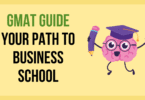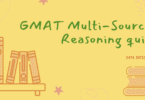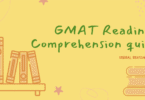The GMAT Focus Edition is a streamlined, more efficient version of the GMAT exam. This mini mock test is designed to give you a hands-on feel for the new format, which includes three core sections: Quantitative Reasoning, Verbal Reasoning, and Data Insights. Use this practice set to familiarize yourself with the question types and sharpen your skills.
Test Structure
| Section | Number of Questions | Time |
| Quantitative Reasoning | 21 questions | 45 minutes |
| Verbal Reasoning | 23 questions | 45 minutes |
| Data Insights | 20 questions | 45 minutes |
1. Quantitative Reasoning (Problem Solving)
Suggested Time: Approximately 12 minutes (Actual GMAT Focus: 21 questions in 45 minutes)
This section contains only Problem Solving questions, which test your foundational math skills.
1. A store owner wants to determine the average number of customers per day over a five-day period. The number of customers on the first four days were 65,80,72, and 91. If the average number of customers for the five-day period was 82, how many customers were there on the fifth day?
(A) 92
(B) 98
(C) 102
(D) 104
(E) 108
2. If a circle has a circumference of 16π centimeters, what is the area of the circle?
(A) 8π cm2
(B) 16π cm2
(C) 32π cm2
(D) 64π cm2
(E) 256π cm2
3. A jacket is on sale for 30% off its original price. If the sale price is $84, what was the original price of the jacket?
(A) $105
(B) $110
(C) $120
(D) $135
(E) $140
2. Verbal Reasoning
Suggested Time: Approximately 10 minutes (Actual GMAT Focus: 23 questions in 45 minutes)
This section focuses on Reading Comprehension and Critical Reasoning.
Reading Comprehension
Directions: The questions in this section are based on the content of the following passage. After reading the passage, choose the best answer to each question.
The concept of “corporate social responsibility” (CSR) has evolved from a niche topic to a central business concern. Initially, CSR was often seen as a philanthropic endeavor—a way for companies to “give back” through charitable donations. However, a more strategic perspective has emerged, where companies integrate social and environmental considerations into their core business operations. Proponents of this view argue that CSR can lead to long-term competitive advantages, such as enhanced brand reputation, improved employee morale, and increased customer loyalty. This strategic approach, sometimes referred to as “creating shared value,” suggests that businesses can simultaneously address societal needs and achieve economic success.
4. According to the passage, the evolution of CSR has involved a shift from:
(A) philanthropic activities to employee benefits.
(B) environmental concerns to social issues.
(C) a niche topic to a central business concern.
(D) short-term goals to long-term profitability.
(E) charitable donations to a strategic business approach.
5. Which of the following is an example of a “long-term competitive advantage” mentioned in the passage?
(A) Short-term increases in quarterly profits.
(B) Improved employee morale.
(C) Reduced operational costs.
(D) Compliance with new government regulations.
(E) Increased dividend payouts to shareholders.
6. The author of the passage would most likely agree with which of the following statements?
(A) CSR should be limited to charitable donations to avoid interfering with business operations.
(B) A company’s social and environmental goals should always take precedence over its economic goals.
(C) Integrating social and environmental goals can benefit a company’s bottom line.
(D) The public views a company’s CSR efforts as purely self-serving.
(E) Companies that focus on CSR will always outperform those that do not.
Critical Reasoning
7. A recent study shows that people who eat breakfast regularly are more likely to have a lower body mass index (BMI) than those who skip breakfast. Therefore, eating breakfast helps people lose weight.
Which of the following, if true, most weakens the argument?
(A) Many people who eat breakfast also exercise regularly.
(B) The study did not control for the type of food consumed for breakfast.
(C) The average BMI of the population has been steadily increasing.
(D) People who skip breakfast tend to consume more calories in their other meals.
(E) The study’s participants were all over the age of 40.
8. The city has decided to install speed bumps on residential streets to reduce the number of traffic accidents. However, the number of accidents in a nearby city that installed speed bumps has not decreased significantly. Therefore, installing speed bumps in our city will not effectively reduce traffic accidents.
Which of the following is an assumption on which the argument depends?
(A) The nearby city’s residents drive faster than residents in our city.
(B) The type of speed bumps installed in both cities are identical.
(C) The speed bumps are the only factor influencing traffic accidents.
(D) Drivers in both cities will respond to the speed bumps in the same way.
(E) The number of accidents in both cities was the same before the speed bumps were installed.
9. The number of people who own smartphones has grown exponentially over the past decade. Simultaneously, the sale of personal computers has seen a significant decline. A market analyst concludes that the decline in personal computer sales is caused by the rise in smartphone ownership.
Which of the following, if true, most strengthens the analyst’s conclusion?
(A) Many people use their smartphones to perform tasks previously done on a personal computer.
(B) The price of personal computers has increased over the past decade.
(C) The number of people who own both a smartphone and a personal computer has increased.
(D) The average lifespan of a personal computer has increased.
(E) The decline in personal computer sales began before the rise in smartphone ownership.
3. Data Insights
Suggested Time: Approximately 10 minutes (Actual GMAT Focus: 20 questions in 45 minutes)
This section includes a variety of question types that test your ability to analyze and interpret data.
Multi-Source Reasoning (MSR)
Directions: Answer the questions based on the two tabs of information provided. You must consult both tabs to determine the answers.
Tab 1:
| Product | Units Sold | Total Revenue | Average Price per Unit |
| Laptop A | 1,500 | $ 1,500,000 | $ 1000 |
| Laptop B | 1,200 | $ 1,800,000 | $ 1500 |
| Laptop C | 1,800 | $ 2,700,000 | $ 1500 |
Tab 2: Q3 2023 Marketing Spend The total marketing budget for Q3 2023 was allocated as follows:
- Online Ads: 40%
- Social Media: 35%
- Print Media: 25%
10. Based on the information provided, for Laptop C, the average price per unit is what percentage of the average price per unit of Laptop A?
(A) 75%
(B) 120%
(C) 150%
(D) 180%
(E) 200%
11. If the total marketing budget was used to market only Laptop B, and the revenue per unit was to stay the same, which of the following statements must be true?
Select one answer for each box.
| Statement | True | False |
| The total revenue for Laptop B would increase. | ||
| The number of units sold for Laptop B would increase. |
Two-Part Analysis
Directions: This question presents a problem with two components. Select one answer choice for each component.
12. A company produces two products, A and B. It takes 2 hours to produce one unit of Product A and 3 hours to produce one unit of Product B. The company has a total of 100 labor hours available. If the company wants to produce a total of 40 units, what is the maximum number of units of Product A and Product B that can be produced?
Select one answer for each box.
| Product A | Product B | |
| Number of Units to Produce | ||
| Options | (A) 10 | (A) 10 |
| (B) 20 | (B) 20 | |
| (C) 30 | (C) 30 |
Data Sufficiency (DS)
Directions: This question type is now part of the Data Insights section. For each question, you must determine whether the data provided in the statements is sufficient to answer the question.
13. Is the integer x a prime number?
(1) x is a factor of 15.
(2) x>3.
(A) Statement (1) alone is sufficient, but statement (2) alone is not sufficient.
(B) Statement (2) alone is sufficient, but statement (1) alone is not sufficient.
(C) Both statements together are sufficient, but neither statement alone is sufficient.
(D) Each statement alone is sufficient.
(E) Statements (1) and (2) together are not sufficient.
14. Is x an integer?
(1) 2x is an integer.
(2) x2 is an integer.
(A) Statement (1) alone is sufficient, but statement (2) alone is not sufficient.
(B) Statement (2) alone is sufficient, but statement (1) alone is not sufficient.
(C) Both statements together are sufficient, but neither statement alone is sufficient.
(D) Each statement alone is sufficient.
(E) Statements (1) and (2) together are not sufficient.
15. A certain jacket was sold for $25 more than its cost. What was the cost of the jacket?
(1) The selling price of the jacket was $125.
(2) The profit from the sale of the jacket was 25% of the cost.
(A) Statement (1) alone is sufficient, but statement (2) alone is not sufficient.
(B) Statement (2) alone is sufficient, but statement (1) alone is not sufficient.
(C) Both statements together are sufficient, but neither statement alone is sufficient.
(D) Each statement alone is sufficient.
(E) Statements (1) and (2) together are not sufficient.
Table Analysis
Directions: Analyze the data in the table to answer the questions.
16. The following table shows the number of employees by department and gender at Company Z.
| Department | Male Employees | Female Employees |
| Sales | 45 | 30 |
| Marketing | 20 | 25 |
| Operations | 60 | 40 |
| Human Resources | 15 | 20 |
For each of the following statements, select True if the statement can be verified using the table. Otherwise, select False.
- The number of male employees in Sales is greater than the number of female employees in Operations. (True / False)
- The total number of employees in Marketing is less than the total number of employees in Human Resources. (True / False)
Graphics Interpretation
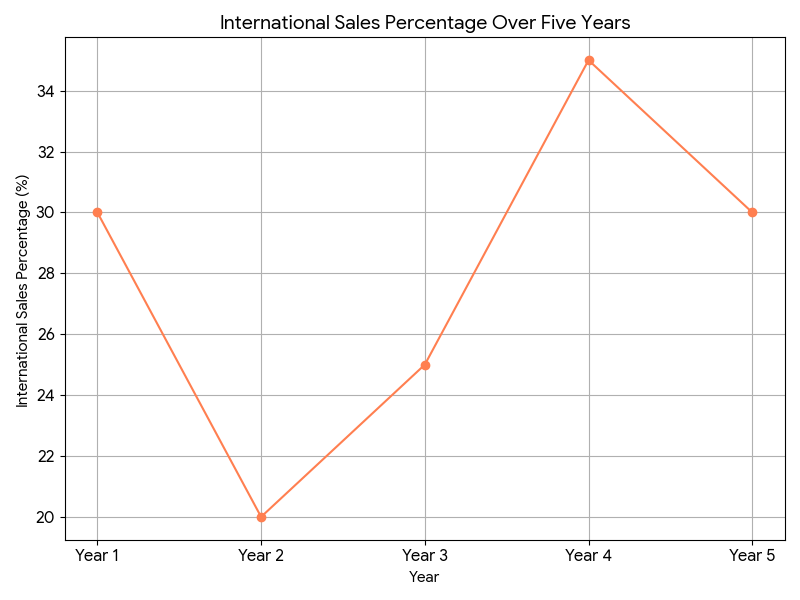
Line Chart (International Sales Percentage): Year 1: 30% Year 2: 20% Year 3: 25% Year 4: 35% Year 5: 30%
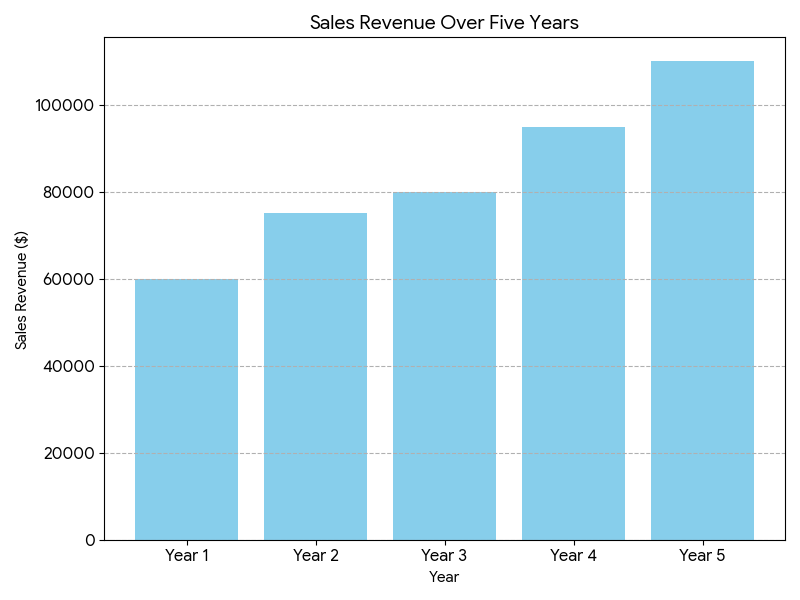
Bar Chart (Sales Revenue): Year 1: $60,000 Year 2: $75,000 Year 3: $80,000 Year 4: $95,000 Year 5: $110,000
Directions: Analyze the charts to answer the questions.
17. The bar chart below shows the sales revenue for a company over a five-year period. The line chart shows the percentage of that revenue that came from international sales.
Based on the charts, select the options that result in a number closest to the estimated total international sales revenue in Year 3.
(A) (1.0−0.25)×$80,000
(B) $80,000/0.25
(C) 0.25×$80,000
(D) 0.25+80,000
18. What was the estimated total domestic sales revenue in Year 4?
(A) $33,250
(B) $58,500
(C) $61,750
(D) $65,000
Answer Key & Explanations
Quantitative Reasoning
1. (C) 102
Explanation: The required total number of customers for five days is 5×82=410. The sum of customers for the first four days is 65+80+72+91=308. The number of customers on the fifth day is the total minus the sum of the first four days: 410−308=102.
2. (D) 64π cm^2
Explanation: The circumference of a circle is C=2πr. Given C=16π, the radius r must be 8. The area of a circle is A=πr^2, Thus, A=π(8^2 )=64π cm^2 .
3. (C) 120
Explanation: If the sale price is 30% off, the sale price represents 100%−30%=70% of the original price (P). So, 0.70P=84. Dividing both sides by 0.70 gives P=84/0.70=120.
Verbal Reasoning
4. (E) charitable donations to a strategic business approach.
- Explanation: The passage explicitly states that CSR evolved from an initial “philanthropic endeavor” to a “more strategic perspective” integrated into core business operations.
5. (B) Improved employee morale.
- Explanation: The passage directly lists “improved employee morale” as an example of a “long-term competitive advantage.”
6. (C) Integrating social and environmental goals can benefit a company’s bottom line.
- Explanation: The author highlights the strategic approach, which “suggests that businesses can simultaneously address societal needs and achieve economic success.” This means social goals can lead to economic benefits.
7. (A) Many people who eat breakfast also exercise regularly.
- Explanation: The argument makes a causal claim (eating breakfast lower BMI). This option introduces an alternative cause (exercise), which weakens the original causal link.
8. (D) Drivers in both cities will respond to the speed bumps in the same way.
- Explanation: The argument draws an analogy between two cities. For the prediction to be valid, the effectiveness of the speed bumps relies on drivers in both cities reacting similarly.
9. (A) Many people use their smartphones to perform tasks previously done on a personal computer.
- Explanation: This option provides the mechanism—the direct link—that explains why the growth of one product (smartphones) would cause the decline of the other (PCs), strengthening the conclusion.
Data Insights
10. Answer: 150%
Explanation: The average price for Laptop C is $1,500. The average price for Laptop A is $1,000. The required percentage is ($1,500/$1,000)×100%=150%.
11. Answer: The first statement is FALSE. The second statement is FALSE.
Explanation: Without additional data showing a direct, guaranteed link between increased marketing spend and increased units sold, we cannot definitively conclude that either the number of units or the total revenue must increase.
12. Answer: Product A = (B) 20; Product B = (B) 20
Explanation: Let A be units of Product A and B be units of Product B.
Total units: A+B=40⟹A=40−B
Total hours: 2A+3B=100
Substitute (1) into (2):
2(40−B)+3B=100
80−2B+3B=100
80+B=100⟹B=20
If B=20, then A=40−20=20.
13. (E) Statements (1) and (2) together are not sufficient.
Explanation:
(1) Factors of 15 are {1,3,5,15}. x could be prime (3, 5) or not prime (1, 15). Not sufficient.
(2) x>3. x could be 4 (not prime) or 5 (prime). Not sufficient.
(1) and (2) together: The factors of 15 that are greater than 3 are {5,15}. Since 5 is prime but 15 is not, we still cannot definitively answer the question “Is x a prime number?”. Therefore, the statements are not sufficient together.
14. (C) Both statements together are sufficient, but neither statement alone is sufficient.
Explanation:
The question asks if x is an integer.
Statement (1) alone: 2x is an integer. This is insufficient because x could be an integer (e.g., if x=3, 2x=6) or a half-integer (e.g., if x=2.5, 2x=5).
Statement (2) alone: x2 is an integer. This is insufficient because x could be an integer (e.g., if x=4, x2=16) or an irrational number (e.g., if x=2, x2=2).
Statements (1) and (2) together: From (1), we know x must be an integer or a half-integer. From (2), we know x must be an integer or an irrational number. The only common possibility between these two sets of numbers is an integer. For example, if x=2.5 (a half-integer), then x2=6.25, which is not an integer. Therefore, both statements together are sufficient to conclude that x must be an integer.
15. (D)Each statement alone is sufficient.
Explanation:
The question asks for the cost of the jacket. The general formula is: Selling Price = Cost + Profit. We are told Profit = $25. So, Selling Price = Cost + 25.
Statement (1) alone: The selling price of the jacket was $125. We can plug this into our equation: 125=Cost+25. We can solve for the Cost, which is $100. Sufficient.
Statement (2) alone: The profit was 25% of the cost. We can write this as: 25=0.25×Cost. We can solve for the Cost: $Cost = 25 / 0.25 = 100. Sufficient.
Since each statement alone provides enough information to solve the problem, each is sufficient.
16. S1(True), S2(False)
Explanation:
- Statement 1: The number of male employees in Sales (45) is greater than the number of female employees in Operations (40). This is True.
- Statement 2: Total employees in Marketing = 20 + 25 = 45. Total employees in Human Resources = 15 + 20 = 35. Since 45 is not less than 35, the statement is False.
17. (C) 0.25×$80,000
Explanation:
To find the total international sales revenue in Year 3, you need to first find the total sales revenue from the bar chart and then multiply by the international sales percentage from the line chart.
In Year 3, the total sales revenue is $80,000, and the international sales percentage is 25%. Therefore, the international sales revenue is 80,000×0.25.
18. (C) $61,750
Explanation:
To find the domestic sales revenue, first find the percentage of sales that were domestic. In Year 4, international sales were 35%, so domestic sales were 100%−35%=65%.
Next, calculate the domestic sales revenue for Year 4 by multiplying the total sales by the domestic percentage: $95,000×0.65=$61,750.
Start Your Free, Section-Wise GMAT Focus Practice Now!


